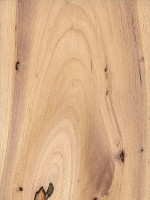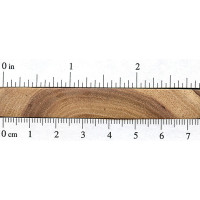 |
Common Name(s): Water Hickory Scientific Name: Carya aquatica Distribution: Southeastern United States Tree Size: 65-100 ft (20-30 m) tall, 1-2 ft (.3-.6 m) trunk diameter Average Dried Weight: 43 lbs/ft3 (690 kg/m3) Specific Gravity (Basic, 12% MC): .61, .69 Janka Hardness: 1,550 lbf (6,900 N)* *Estimated hardness based on specific gravity Modulus of Rupture: 17,800 lbf/in2 (122.8 MPa) Elastic Modulus: 2,020,000 lbf/in2 (13.93 GPa) Crushing Strength: 8,600 lbf/in2 (59.3 MPa) Shrinkage:Volumetric: 13.6% |
Color/Appearance: Heartwood tends to be light to medium brown, with a reddish hue; sapwood is a paler yellowish brown. Boards with contrasting heartwood and sapwood create a somewhat rustic appearance that’s sometimes marketed as Calico Hickory.
Grain/Texture: Grain is usually straight, though occasionally wavy, with a medium texture. Pores are medium-sized and open.
Rot Resistance: Considered to be non-durable to perishable regarding heartwood decay, and also very susceptible to insect attack.
Workability: Difficult to work, with tearout being common during machining operations if cutting edges are not kept sharp; the wood tends to blunt cutting edges. Glues, stains, and finishes well. Responds well to steam bending.
Odor: No characteristic odor.
Allergies/Toxicity: Besides the standard health risks associated with any type of wood dust, no further health reactions have been associated with Water Hickory. See the articles Wood Allergies and Toxicity and Wood Dust Safety for more information.
Pricing/Availability: Various species of Hickory and Pecan (Carya genus) are typically mixed together and simply sold as Hickory. Prices are usually in the low to mid range, depending upon local availability. Hickory prices should compare similarly to other utility hardwoods such as Red Oak or Soft Maple.
Sustainability: This wood species is not listed in the CITES Appendices or on the IUCN Red List of Threatened Species.
Common Uses: Tool handles, ladder rungs, wheel spokes, flooring, etc.
Comments: Hickory is among the hardest and strongest of woods native to the United States. On average, Hickory is denser, stiffer, and harder than either White Oak or Hard Maple. The wood is commonly used where strength or shock-resistance is important.
Water Hickory falls into the Pecan-Hickory grouping, which tends to be slightly stabler but weaker than the True-Hickories, and is considered to be a semi-ring-porous wood. The strength characteristics of Water Hickory are somewhat influenced by the spacing of its growth rings. In general, wood from faster-growing trees, with wider spaced growth rings, tends to be harder, heavier, and stronger than wood from slower-growing trees that have rings which are closer together.
In addition to strength and hardness applications, the wood of Carya species also has a very high thermal energy content when burned, and is sometimes used as fuelwood for wood stoves. Additionally, Hickory is also used as charcoal in cooking meat, with the smoke imparting additional flavor to the food.








I’d like to have some drums sticks made of something with a Janka rating of 1200 and over, is it easy to obtain dowels in this wood?
I was always told about that the more narrow the board the more stable the board, my question is it true that a 3/4″x 3-1/4″ hickory hardwood flooring is more stable then a 3/4″x 4-1/4 hardwood
flooring?
Thanks inadvance
Rick G
Stability in wood terms means how much it expands and contracts with changes in moisture levels. Wood, even when it’s dry, is sponge-like and is always picking up or giving off water from or to the surrounding air. Different species will vary quite a bit, some are not too stable, even if used as flooring, red oak for example. Most, if not all species are more stable in the radial direction (quartersawn) than the tangential direction (flatsawn). The difference between these two is why boards cup as they dry. Over long periods of time, it’s theorized that wood loses its… Read more »